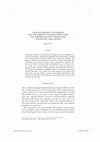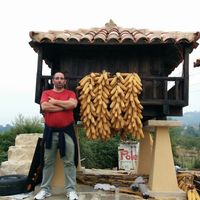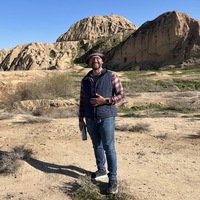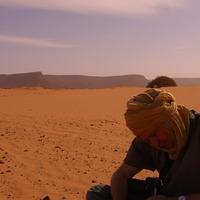Books and Books Chapters by Ignacio Arce
Presentation and launching of the Book Digging up Jericho, which includes the chapter:
"A New Um... more Presentation and launching of the Book Digging up Jericho, which includes the chapter:
"A New Umayyad Mosque at Khirbet el-Mafjar,
and Other Discoveries:
A New Understanding through Architectural Stratigraphy
and Landscape Archaeology"

This chapter of the book Roman Military Architecture on The Frontiers analyzes the physical trans... more This chapter of the book Roman Military Architecture on The Frontiers analyzes the physical transformations and changes of use of Roman military installations on the limes Arabicus, between the 4th century AD and the 7th century. The transformations identified in these structures during this “longue durée” illustrate and correspond to three key transitional periods that determine the history of the Levant from the apex of Roman domination in Oriens, until the advent of Islam.
They are also key to understanding this historical shift. In accordance with the aim of this volume, to foreground the military architecture of the limites during late antiquity, we will focus on the first two transitional phases of the four historical periods, and the three related shifts that can be identified in the military installations. The last shift, coinciding with the advent of Islam and the transformation of these former Roman forts into Umayyad qusur is only presented briefly, as it exceeds the scope of this volume. Nonetheless, reference is made to it as an essential aspect of this diachronic analysis, and the final output of the processes is described and analyzed.

The study of the building techniques, the stratigraphic
sequences and the typological transformat... more The study of the building techniques, the stratigraphic
sequences and the typological transformations of these three
quadriburgia within the broad context of the socio-political
changes operated in the region in Late Antiquity, has helped
not only to clarify the changes of use they underwent and the
technology involved, but also has shed light on their historical
context during the transitional period from Late Antiquity
to Early Islam. These structures bear witness of these historical
periods, offering an ideal and diversified catalogue of
building techniques, architectural typologies, and what is more
important, a recurrent pattern of physical transformations and
changes of use from the 3rd throughout the 8th C. AD. This
precise pattern involves the transformation and re-use of these
military structures in the 6th C. AD into religious (monasteries),
civil and palatine ones. These changes were apparently
carried out in most cases by the Ghassanids, the Christian Arab
foederati tribes entrusted with the task of the defence of the
Limes Arabicus as a result of the change of the defensive strategy
operated by Justinian. The information retrieved (technical
and historical) offers a new insight to some key issues of
the historical periods involved: These two sources of information
clarify the technical improvements and transformations
operated in the buildings, as well as the historical significance
that can be elicited from these changes.

Late Antique Archaeology, 2008
This paper analyses the introduction, merging and use of building materials and techniques, archi... more This paper analyses the introduction, merging and use of building materials and techniques, architectural typologies and urban patterns, during the Umayyad period in Bilad al-Sham (present day Syria, Palestine and Jordan), within the general framework of the cultural interchange that took place in that period between eastern and western traditions. For most of its history, and especially in Antiquity, this was a frontier area, or a buffer zone in modern terms, between the main regional powers: Egypt and the successive Mesopotamian empires; Persia and Greece; the Seleucid and Ptolemaic kingdoms; Rome and Parthia; Byzantium and the Sassanians. As a result, it not only witnessed war, invasion and destruction, but also fruitful economic and cultural interchange. This frontier was lifted twice: fi rst, during the reign of Alexander, and, secondly with the rise of Islam.
Limina / Limites Archeologie, storie, isole e frontiere nel Mediterraneo (365-1556) 1 Published b... more Limina / Limites Archeologie, storie, isole e frontiere nel Mediterraneo (365-1556) 1 Published by Archaeopress Publishers of British Archaeological Reports Gordon House 276 Banbury Road Oxford OX2 7ED England bar@archaeopress.com www.archaeopress.com BAR S2386 Limina / Limites Archeologie, storie, isole e frontiere nel Mediterraneo (365-1556) 1 La Transgiordania nei secoli XII-XIII e le 'frontiere' del Mediterraneo medievale Abstract (2008) Romans, Ghassanids and Umayyads and the transformation of the Limes Arabicus: from coerciveand deterrent diplomacy towards religious proselytism and political clientelarism.
Papers by Ignacio Arce
Near Eastern Archaeology, 2016
Khirbet al-Mafjar is an Islamic monument near Jericho, famous for its mosaics, statues and stucco... more Khirbet al-Mafjar is an Islamic monument near Jericho, famous for its mosaics, statues and stuccos of the Umayyad period. The site was excavated in the 1930s and 1940s. New excavations called the Jericho Mafjar Project are a joint venture by the Palestinian department and the University of Chicago. The present article demonstrates the process of hypothesis and excavations employed in the course of this research. The most recent season in 2015 found a new data set using remote sensing techniques. This new information has produced a new hypothesis on a Roman occupation, presented from different perspectives.
The aim of this paper is to discuss, on the evidence of the vaults and roofing systems present in... more The aim of this paper is to discuss, on the evidence of the vaults and roofing systems present in different structures built during the Umayyad period, specially those from Qasr Harane, the birth of the first ribbed vaults as a development of the diaphragm arch roofing system, that will be latter developed in Al Anda]us (Bab al Mardun mosque, Cordoba mosque, Vera Cruz and Torres del Rio churches, etc), and in the Transoxus-Khorassan Region (Sultan Sanjar mausoleum at Merv, etc). Besides, important remarks about the building techniques used in the Middle East for the construction of these arches, and relevant for understanding their structural and design concepts are also presented.
Umayyad architecture and construction techniques are, up to a point, the result of a successful e... more Umayyad architecture and construction techniques are, up to a point, the result of a successful eclectic merging of Late Roman traditions and Partho-Sassanian ones, due to the need to establish new cities in the conquered territories and to create a new “aulic” imagery and an appropriate architectural framework for the new power. The seizing of key areas of the Byzantine empire (Syria, Egypt) and the whole of the Sassanian one (Mesopotamia, Persia and Central Asia), provided the new rulers with two endless sources of construction traditions, artisans and materials, that blended, and gave birth to new and idiosyncratic one.











Uploads
Books and Books Chapters by Ignacio Arce
"A New Umayyad Mosque at Khirbet el-Mafjar,
and Other Discoveries:
A New Understanding through Architectural Stratigraphy
and Landscape Archaeology"
They are also key to understanding this historical shift. In accordance with the aim of this volume, to foreground the military architecture of the limites during late antiquity, we will focus on the first two transitional phases of the four historical periods, and the three related shifts that can be identified in the military installations. The last shift, coinciding with the advent of Islam and the transformation of these former Roman forts into Umayyad qusur is only presented briefly, as it exceeds the scope of this volume. Nonetheless, reference is made to it as an essential aspect of this diachronic analysis, and the final output of the processes is described and analyzed.
sequences and the typological transformations of these three
quadriburgia within the broad context of the socio-political
changes operated in the region in Late Antiquity, has helped
not only to clarify the changes of use they underwent and the
technology involved, but also has shed light on their historical
context during the transitional period from Late Antiquity
to Early Islam. These structures bear witness of these historical
periods, offering an ideal and diversified catalogue of
building techniques, architectural typologies, and what is more
important, a recurrent pattern of physical transformations and
changes of use from the 3rd throughout the 8th C. AD. This
precise pattern involves the transformation and re-use of these
military structures in the 6th C. AD into religious (monasteries),
civil and palatine ones. These changes were apparently
carried out in most cases by the Ghassanids, the Christian Arab
foederati tribes entrusted with the task of the defence of the
Limes Arabicus as a result of the change of the defensive strategy
operated by Justinian. The information retrieved (technical
and historical) offers a new insight to some key issues of
the historical periods involved: These two sources of information
clarify the technical improvements and transformations
operated in the buildings, as well as the historical significance
that can be elicited from these changes.
Papers by Ignacio Arce
"A New Umayyad Mosque at Khirbet el-Mafjar,
and Other Discoveries:
A New Understanding through Architectural Stratigraphy
and Landscape Archaeology"
They are also key to understanding this historical shift. In accordance with the aim of this volume, to foreground the military architecture of the limites during late antiquity, we will focus on the first two transitional phases of the four historical periods, and the three related shifts that can be identified in the military installations. The last shift, coinciding with the advent of Islam and the transformation of these former Roman forts into Umayyad qusur is only presented briefly, as it exceeds the scope of this volume. Nonetheless, reference is made to it as an essential aspect of this diachronic analysis, and the final output of the processes is described and analyzed.
sequences and the typological transformations of these three
quadriburgia within the broad context of the socio-political
changes operated in the region in Late Antiquity, has helped
not only to clarify the changes of use they underwent and the
technology involved, but also has shed light on their historical
context during the transitional period from Late Antiquity
to Early Islam. These structures bear witness of these historical
periods, offering an ideal and diversified catalogue of
building techniques, architectural typologies, and what is more
important, a recurrent pattern of physical transformations and
changes of use from the 3rd throughout the 8th C. AD. This
precise pattern involves the transformation and re-use of these
military structures in the 6th C. AD into religious (monasteries),
civil and palatine ones. These changes were apparently
carried out in most cases by the Ghassanids, the Christian Arab
foederati tribes entrusted with the task of the defence of the
Limes Arabicus as a result of the change of the defensive strategy
operated by Justinian. The information retrieved (technical
and historical) offers a new insight to some key issues of
the historical periods involved: These two sources of information
clarify the technical improvements and transformations
operated in the buildings, as well as the historical significance
that can be elicited from these changes.
This project is carried out since 2012 in collaboration with colleagues from Mainz University (Dr. Thomas Weber) and the Ècole Practique de Hautes Ètudes du Paris (Dr. Denis Feissel).
The aim of this project is threefold: Firstly, to retrieve and to carry out the exegesis of the original text of the imperial edict (clarifying key issues regarding the organization of the Roman army and the defense of the limes Arabicus in the 5th-6th C CE); Secondly, to seek the original location of this inscription, and to study its historical meaning and significance; Thirdly, to carry out a replica intended to present the inscription to the visitor, but also to be used as a didactic and educative resource, aimed at teaching Greek epigraphy to the students from Jordan universities.
In this Paper are presented and discussed the epigraphic evidence, paying attention to the exegesis of the text, its contents and the vicissitudes of the edict inscription and its restoration.
In this lecture will be presented the results of the research conducted by the Spanish Archaeological Mission to Jordan, directed by Dr. Arce, during the last 22 years, under the title "From Rome to Islam: Qasr al-Hallabat and the 'Desert Castles' in Jordan".
Roman Forts, Ghassanid Monasteries, Umayyad Palaces; Antecedents,
Transformations and Changes of Use